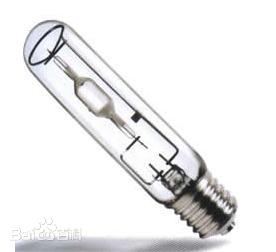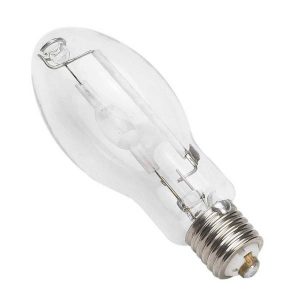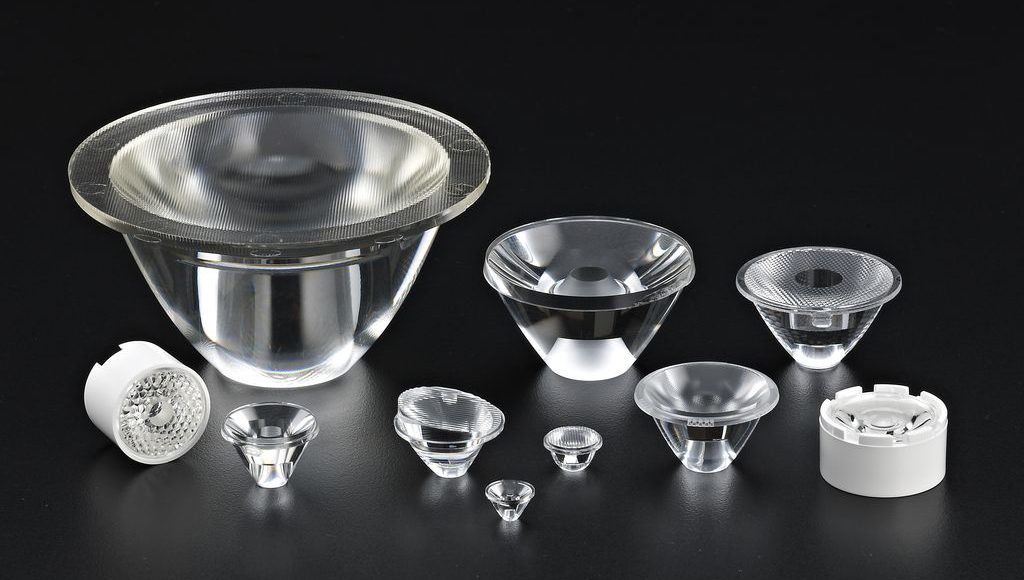The Definition of HID Light
High intensity Discharge Lamp refers to a high-pressure gas discharge lamp that is filled with a mixture of inert gases including xenon, but does not have the filament of a halogen lamp, referred to as HID xenon lamp. It can also be called a metal halide lamp. Divided into xenon lamps for automobiles and xenon lamps for outdoor lighting.
Xenon lamps are also called HID gas discharge headlamps in the field of automotive lamps. It replaces traditional tungsten filaments with high-pressure xenon gas wrapped in a quartz tube to provide higher color temperature and more concentrated lighting. Because the xenon lamp uses a high-voltage current to activate the xenon gas to form an arc, it can continuously discharge light between the two electrodes. The power of an ordinary car tungsten bulb reaches 55 watts, while the xenon lamp only needs 35 watts, which is nearly a half.
Xenon lamps can significantly reduce the load on the vehicle’s electrical system. The color temperature of car xenon lamps is between 4000K and 6000K, which is much higher than that of ordinary car headlight bulbs. It has high brightness. The light color of the 4300K xenon lamp is white and yellowish. Due to the lower color temperature, the visual effect is yellowish, and the light penetration is stronger than the high color temperature lamp, which can improve the driving safety at night and in heavy fog. It was first used in air transportation. There are two types of xenon lamps that are widely used in the market, one is automotive lighting and the other is motorcycle lighting. But it has been used in cars in large quantities in the past two decades.
The luminous principle of HID lamp
The luminous principle of the xenon lamp is to fill the UV-cut anti-ultraviolet crystal quartz glass tube with a variety of chemical gases, most of which are xenon (Xenon) and iodide, etc., and then through the supercharger (Ballast) to The direct voltage of volts is instantly pressurized to a voltage of 23,000 volts, and the xenon electrons in the quartz tube are excited to dissociate through the high-voltage amplitude, and a light source is generated between the two electrodes. This is the so-called gas discharge. The white super-strong arc light produced by xenon gas can increase the color temperature of the light. It is similar to the sunlight in daylight. The current required for HID operation is only 3.5A, the brightness is three times that of traditional halogen bulbs, and the service life is longer than traditional The halogen bulb is 10 times longer.
Components of HID lamp
Generally speaking, HID xenon lamp is composed of lamp holder (xenon bulb), electronic rectifier (also called ballast, voltage stabilizer, adaptor, etc.), wire group control box, etc.:
- Lamp holder: If you observe carefully, you will find that the HID xenon lamp holder does not have a filament. The current between the electrodes is used to promote the collision of xenon molecules to produce brightness. There is no problem of tungsten filament burnout (there is no tungsten filament. Xenon lights),
- Program-controlled ballast: Using the 12V DC voltage of the battery, after a series of conversion, control, protection, boosting, frequency conversion and other actions, an instantaneous ignition high voltage of 23000V is generated to ignite the lamp holder, and then maintain 85V after lighting. AC voltage, starting current is about 8A, working current is about 4A. In 2013, the most intelligent electronic ballast launched on the market is the “program-controlled ballast”, which uses modern computer technology to compile a specific program to implant a chip to control the circuit, so that it can complete detection, calculation and automatic matching of xenon lamps, thereby To achieve the best performance between the two
- Wire group: generally made of flame-retardant materials. By increasing the cross-sectional area of the power cord, the current passing capacity is improved and the normal operation of the HID xenon lamp is ensured. Some H4 models are equipped with a relay wire group for work control.
How to convert halogen lamps into HID lamps
So how should the car xenon lamp be changed? How much is the charge reasonable?
The modification of car lights is divided into three levels:
- Primary modification: white light halogen bulb and high-power halogen bulb, modification cost: $10-$50, modification effect is not obvious (not recommended)
- Intermediate modification: rechargeable xenon light bulb, modification cost: $50-$135, modification effect: strongly not recommended (the cost is not high, but during driving, the driver on the opposite side will be dazzling and unable to see clearly, causing a car accident)
- Top modification: hid xenon lamp + modification assembly + lens modification cost: $500-$1600, the modification effect is excellent (after installing the lens, the xenon light will gather, no longer scattered, not dazzling, safe)
-
Replace the halogen bulb with a xenon bulb
Advantages: Xenon bulbs suitable for halogen bulbs such as H7, H4, H3, H1, HB3, HB4, etc. have been introduced on the market, so almost all models can be applied.
Disadvantages: On the one hand, because the size and size of some brands of xenon bulbs are different from the original halogen bulbs, the light-emitting part must deviate from the focus position, so that the car lights have serious negative effects such as no focusing and no correct high beam function. The impact may even increase the chance of dazzling the car hundreds of times. On the other hand, because the circuit of the original car is changed, once the product quality problem occurs, it is likely to cause a short circuit and fire. Many irresponsible modification shops operate in this way, which not only affects car owners, but also makes many outsiders demonize the change of lights. In fact, as long as you follow the correct method, good products, and a responsible attitude, changing the lights will not only not give the car owners. Bring troubles and bring safety to car owners.
-
Replace the headlight assembly
Advantages: This modification method mainly uses the original supporting xenon headlights, that is, the xenon light source is combined with the specially designed light distribution mirror and reflector, so it becomes the most ideal modification method.
Disadvantages: expensive.
-
Install xenon auxiliary lights on the front or roof
Advantages: This kind of modification is relatively flexible. Users can choose suitable products according to the front wall shape of the vehicle and their own preferences, choose a reasonable installation location for installation, and meet individual needs. The xenon auxiliary lights are mainly high beams, and the outer diameter is generally as small as 80-90 mm and as large as 200 mm. They can be suitable for trucks, off-road vehicles, cars and other different models.
Disadvantages: There are certain size requirements for the front bumper and grille of the vehicle, which need to be carefully measured before modification.
HID bulb type
The models of xenon lamps are divided into bulbs, generally divided into three series: 900 series, H series and D series. (D series is usually lens series)
The 900 series have 9004\9005\9006\9007.
H series have H1\H3\H7\H8\H11\H4.
The D series have D1\D2\D4.
These models correspond to the car’s ordinary headlight bulb models. There is also a modified car headlight, called lens\with angel eyes, which is a modified xenon lamp. The lens is for the headlight The concentration of light is better, but the airtightness of the modified headlights is not very good. Angel eyes play a decorative effect and are not practical. In Europe, the use of xenon bulbs must also use lenses that meet the quality standards and meet the regulations And the headlight cleaning device, this is to prevent the formation of improper use of xenon headlights for safety hazards caused by driving. There are no relevant domestic regulations, but it is still recommended to at least match the corresponding lens when refitting xenon headlights, and carry out corresponding debugging .
Lamp holder model
There is a one-to-one correspondence between the HID model and the halogen bulb, that is, what model the original halogen bulb is, then the same model must be used when refitting the HID.
H series: H1, H3, H4, H6, H7, H8, H9, H10, H11, H13, etc.;
90 series: 9004 (HB1), 9005 (HB3), 9006 (HB4), 9007 (HB5), etc.;
D series: D1S, D1C, D1R, D2R, D1C, D2C, D3C, D4C, etc.;
Others: 880, 881.
Models such as H1, H4, H7, 9005, 9006, 9007 are more commonly used in automotive HID.
The four models of H4, H13, 9004, and 9007 have two tungsten filaments in the original halogen bulbs, one for the far light and the other for the near light. However, because the xenon lamp cannot be used in one tube at the same time Meet the low beam and high beam, so there are four series respectively, such as: H (also known as single light, even if there is only high beam or low beam). Under high temperature, it is easy to burn, and the average life span is only 250 hours; HID lamp uses gas discharge to emit light, there is no tungsten wire, and it is not easy to be damaged. H4-3, H13-3, 9004-3, 9007-3 and H4-H/L, H13-H/L, 9004-H/L, 9007-H/L models are all xenon lamps with integrated far and near light , Where H/L is the representative of high and low (High/Low).
Advantages and disadvantages of HID lights
1. The advantages of xenon lamps
The white super-strong arc light produced by xenon can increase the color temperature value of the light. It is similar to the sun’s light in daylight. The current required for HID operation is only 3.5A, the brightness is three times that of traditional halogen bulbs, and the service life is longer than traditional halogen bulbs. 10 times longer.
Its outstanding advantages are as follows:
- The color temperature of the xenon lamp ranges from 3000K to 12000K, and the color temperature of 6000K is similar to that of sunlight.
But it contains more green and blue components, so it presents blue-white light. This blue-white light
Improve the brightness of road signs and signs.
- The brightness efficiency of HID is three times higher than that of halogen lamps, which has obvious effect on improving the visibility of driving at night and in fog.
- The luminous flux emitted by the xenon lamp is more than twice that of the halogen lamp, and the efficiency of converting electric energy into light energy is also 70% higher than that of the halogen lamp. Therefore, the xenon lamp has a relatively high energy density and light.
Illumination intensity, and the operating current is only half of the halogen lamp. The increase in the brightness of car lights also effectively expands the visual range in front of the car, thereby creating safer driving conditions.
- Power saving 1/2, halogen lamp consumes more than 60W of power, xenon lamp only needs 35W of power.
- Because the xenon lamp has no filament, it will not cause the problem of being scrapped due to the broken filament. The service life is much longer than that of the halogen lamp. The service life of the xenon lamp is equivalent to the entire running time of the average car cycle.
- Once the xenon lamp fails, it will not be extinguished instantaneously, but will be extinguished by gradually dimming (or quickly lit), so that the driver can win time in the dark driving and stop urgently.
- Xenon headlights will not produce excess glare, and will not cause interference to the drivers of oncoming cars.
Xenon headlights are also called HID gas discharge headlights. It uses high-pressure xenon wrapped in a quartz tube instead of traditional tungsten filaments to provide higher color temperature and more concentrated lighting. Because the xenon lamp uses high-voltage current to activate the xenon gas to form an arc, it can continuously discharge light between the two electrodes. The power of an ordinary car bulb reaches 65 watts, while the xenon lamp only needs 35 watts, which is nearly doubled. Xenon lamps can significantly reduce the burden on the vehicle’s electrical system.
The color temperature of car xenon lamps is between 4000K and 6000K, which is much higher than that of ordinary car headlight bulbs. It has high brightness. The light color of the 4300K xenon lamp is white and yellowish. Due to the lower color temperature, the visual effect is yellowish, and the light penetration is stronger than the high color temperature lamp, which can improve the driving safety at night and in heavy fog. When you are driving at night on a road with no lights, the road is narrow and curved. At this time, if your car lights will be brighter and shine further, then the safety of driving will inevitably improve a lot. Xenon
The HID lamp is a new generation of headlamps developed based on driving safety at night.
2. Disadvantages of xenon headlights
Xenon headlights naturally have some shortcomings as a modified product.
For example, some of the modified headlights have poor concentrating performance, some car’s fault warning lights will turn on, some cars will burn computer boards, and some individual models will automatically turn off and other adverse reactions.
Prompt:
These are because the combination of the modified product and the original car is not ideal, not that the product is not good.
Because as a light product, as long as it is on, it is good! There are several factors for not focusing:
- The combination of bulb and lamp cup is not good.
- The installation is not in place or the debugging is not good.
The fault light is on because the bulb of the original car has high power consumption (55W), and the power of the xenon lamp is low
35W), so after the modification, its power is not enough and it alarms. As a xenon lamp, its starting current is
8A, and the original car started at 6.2A, so the original car’s line settings do not match. Need to go to the 4S shop to change the circuit mode. Automatic flameout is caused by electromagnetic interference due to excessive starting current.
This can be done by keeping the ballast away from the engine or changing to a low-current starting ballast during installation! Basically all situations can be resolved.


